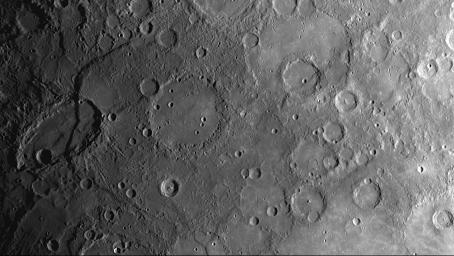Revisiting Some of MESSENGER’s Early Discoveries and Anticipating More in 2011
Caption:

Click on the image for larger annotated version
When MESSENGER first
flew by
Mercury on January 14, 2008, MDIS acquired images of a large portion of Mercury's surface that had never previously been seen by spacecraft. This
mosaic
of NAC images shows some of the geologic features discovered during that first flyby that have been subsequently named: the curving cliff face of
Beagle Rupes
, the elongated crater
Sveinsdottir
, and the craters
Izquierdo
and
Kunisada
flooded with lava.
This year, the MESSENGER spacecraft is positioned once again to visit the Solar System's innermost planet. However, this time, the spacecraft won't just pass by. On March 18, 2011, a 15-minute maneuver will place MESSENGER in orbit about Mercury, making it the first spacecraft ever to do so. The MESSENGER mission will then begin an extensive year-long science campaign to
unravel Mercury's mysteries
. 2011 promises to be an exciting year of further discoveries for the MESSENGER mission.
Date Acquired:
January 14, 2008
Instrument:
Narrow Angle Camera (NAC) of the Mercury Dual Imaging System (MDIS)
Scale:
Izquierdo crater is 170 kilometers (106 miles) in diameter
Background Info:
These images are from MESSENGER, a NASA Discovery mission to conduct the first orbital study of the innermost planet, Mercury. For information regarding the use of images, see the MESSENGER
image use policy
.
Cataloging Keywords:
| Name |
Value |
Additional Values |
| Target |
Mercury |
|
| System |
|
|
| Target Type |
Planet |
|
| Mission |
MESSENGER |
|
| Instrument Host |
MESSENGER |
|
| Host Type |
Orbiter |
|
| Instrument |
Mercury Dual Imaging System (MDIS) |
|
| Detector |
Narrow Angle Camera (NAC) |
|
| Extra Keywords |
Crater, Grayscale |
| Acquisition Date |
|
| Release Date |
2011-01-04 |
| Date in Caption |
2008-01-14 |
2011-03-18 |
| Image Credit |
NASA/Johns Hopkins University Applied Physics Laboratory/Carnegie Institution of Washington |
| Source |
photojournal.jpl.nasa.gov/catalog/PIA13748 |
| Identifier |
PIA13748 |

 Planetary Data System
Planetary Data System

